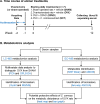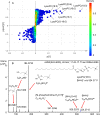Lowering of lysophosphatidylcholines in ovariectomized rats by Curcuma comosa
- PMID: 35588422
- PMCID: PMC9119514
- DOI: 10.1371/journal.pone.0268179
Lowering of lysophosphatidylcholines in ovariectomized rats by Curcuma comosa
Abstract
Decline of ovarian function in menopausal women increases metabolic disease risk. Curcuma comosa extract and its major compound, (3R)-1,7-diphenyl-(4E,6E)-4,6-heptadien-3-ol (DPHD), improved estrogen-deficient ovariectomized (OVX) rat metabolic disturbances. However, information on their effects on metabolites is limited. Here, we investigated the impacts of C. comosa ethanol extract and DPHD on 12-week-old OVX rat metabolic disturbances, emphasizing the less hydrophobic metabolites. Metabolomics analysis of OVX rat serum showed a marked increase compared to sham-operated rat (SHAM) in levels of lysophosphatidylcholines (lysoPCs), particularly lysoPC (18:0) and lysoPC (16:0), and of arachidonic acid (AA), metabolites associated with inflammation. OVX rat elevated lysoPCs and AA levels reverted to SHAM levels following treatments with C. comosa ethanol extract and DPHD. Overall, our studies demonstrate the effect of C. comosa extract in ameliorating the metabolic disturbances caused by ovariectomy, and the elevated levels of bioactive lipid metabolites, lysoPCs and AA, may serve as potential biomarkers of menopausal metabolic disturbances.
Conflict of interest statement
The authors have declared that no competing interests exist.
Figures






Similar articles
-
Serum lipidomics analysis of ovariectomized rats under Curcuma comosa treatment.J Ethnopharmacol. 2016 Nov 4;192:273-282. doi: 10.1016/j.jep.2016.07.054. Epub 2016 Jul 19. J Ethnopharmacol. 2016. PMID: 27448454
-
Curcuma comosa reduces visceral adipose tissue and improves dyslipidemia in ovariectomized rats.J Ethnopharmacol. 2018 Apr 6;215:167-175. doi: 10.1016/j.jep.2017.12.027. Epub 2017 Dec 20. J Ethnopharmacol. 2018. PMID: 29273438
-
Improvements of insulin resistance in ovariectomized rats by a novel phytoestrogen from Curcuma comosa Roxb.BMC Complement Altern Med. 2012 Mar 30;12:28. doi: 10.1186/1472-6882-12-28. BMC Complement Altern Med. 2012. PMID: 22463706 Free PMC article.
-
A diarylheptanoid phytoestrogen from Curcuma comosa, 1,7-diphenyl-4,6-heptadien-3-ol, accelerates human osteoblast proliferation and differentiation.Phytomedicine. 2013 Jun 15;20(8-9):676-82. doi: 10.1016/j.phymed.2013.02.008. Epub 2013 Apr 1. Phytomedicine. 2013. PMID: 23557993 Free PMC article.
-
Long-term effect of phytoestrogens from Curcuma comosa Roxb. on vascular relaxation in ovariectomized rats.J Agric Food Chem. 2012 Jan 25;60(3):758-64. doi: 10.1021/jf203173b. Epub 2012 Jan 12. J Agric Food Chem. 2012. PMID: 22225491
References
Publication types
MeSH terms
Substances
LinkOut - more resources
Full Text Sources

